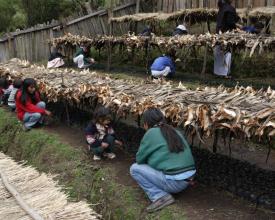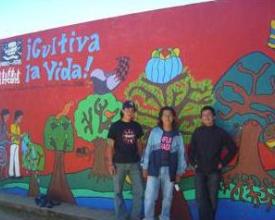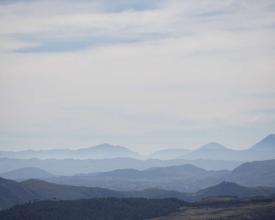
The Tacaná Watersheds: Implementing transboundary water governance through local community ecosystem based action

Despite their great potential and strategic importance the watersheds of the Tacaná volcano are vulnerable both ecologically and politically. IUCN (through the Water and Nature Initiative, WANI) and partners therefore set up a demonstration project in these watersheds, which combined pilot livelihood projects (water, soil and environmental conservation) and bottom-up integrated governance of water resources management (freshwater ecosystem management).
Context
Challenges addressed
The watersheds of the Tacaná volcano are of great strategic importance for both Guatemala and Mexico since they supply water to the cities located downstream, irrigation water for agriculture and, in the lower reaches, fishing. Despite this great potential, the area is vulnerable both ecologically and politically. The climate is tropical humid and there a high occurrence of hurricanes as well as volcanic activity. Deforestation and degradation of the upper watersheds and of river banks has led to erosion and flooding and reduced capacity of the watersheds to absorb water. The area is also exposed to a number of socio-political shortcomings such as lack of technical support between institutions, indigenous people marginalization, high illiteracy and mortality rates, very high population growth, and complex land tenure rights.
Location
Process
Summary of the process
The building blocks work together to meet the main goal of the Water and Nature Initiative (WANI), which is to “mainstream an ecosystem approach into catchment policies, planning and management”. The activities are therefore structured around the Initiative’s strategic objectives including:
- To demonstrate ecosystem management in river basins.
- To support wise governance of water resources and wetlands.
- To develop and apply economic tools and incentive measures.
- To empower people to participate in sustainable water management.
- To improve knowledge to support decision making.
- To learn lessons to raise awareness on wise water use.
Building Blocks
Knowledge mobilisation
Mobilisation was achieved through economic valuation of water resources, provision of locally available information and capacity building for learning and leadership.
- The project’s Living Water Partnership established a Payment for Ecosystem Services scheme in Guatemala to protect and restore the Tacaná Watersheds’ natural resources, focussing primarily on water.
- WANI facilitated grassroots mobilisation in Mexico through the establishment of the ‘virtual water resource libraries’ in the town halls of five municipalities. These provided access to up-to-date information and knowledge on water resources and the environment in the region.
- Learning from the pilot projects under WANI has been incorporated into the University of San Carlos’s academic studies through 10-month internships. These programmes are creating a critical mass of professionals trained in WANI concepts, approaches and practice who will eventually go into professional positions in different institutions and organizations active in the area, creating an influential feedback loop.
Enabling factors
- Trust and good relationship with local institutions.
- Locally available information.
Lesson learned
-
Generation of local knowledge leads to more disaster preparedness and increasing political openness over water at the municipal and State levels.
-
The scope of the project could have been wider in terms of stakeholder partnerships. The private sector was included in payments for watershed services schemes in the middle part of the catchment, but only for smaller scale holders. In the lower part, large palm and banana tree growers from Guatemala use large amounts of water with no compensation for water retention services upstream.
Water, soil and environmental conservation
Unregulated land use change in the upper watershed had been especially damaging on steep hillsides and deforestation reduced the capacity of the soils to retain water. The resulting erosion strongly increased the risk of floods and mudslides. WANI and partners supported the design of numerous community pilot projects which addressed water, soil and environmental conservation. Women made up 90% of these groups, empowering them to take a more proactive role in the development of their communities. The pilot projects were the basis for bringing people together to organize themselves into micro-watershed committees. Examples include:
- Forest nurseries for reforestation and promotion of agroforestry on farms;
- Facilitating development and networking of community enterprises and cooperatives working in, for example, beekeeping, fish farming, forest butterfly farm ecotourism;
- Community gardens, organic farming and soil conservation projects;
- Construction of septic systems to improve sanitation and raise water quality in the Suchiate River;
- Protection of springs for domestic water supply and installation of piped distribution;
- Establishment of a demonstration and training centre in Chiapas for integrated management of watersheds.
Enabling factors
The micro-watershed model was central to the achievement of building the adaptive capacity of the watershed and local livelihoods through empowerment of community-owned institutions.
Lesson learned
This restoration of ecosystem services in the upper watershed has achieved results for water supply, farm livelihoods and disaster resilience. Through taking an ecosystems approach to IWRM, which focuses on environmental restoration for livelihood security, these small scale initiatives have energised the communities to self-organise and has enhanced their development opportunities. Community-level participation in transboundary water resources management is achievable and adds value to conventional transboundary approaches. Planning and implementation of IWRM can be successfully shared between communities across boundaries.
Self-organisation for improved governance
Small business enterprise: In Guatemala, WANI was instrumental in supporting the emergence of a youth-run cooperative enterprise called ‘Jóvenes en la Missión’ (Youth in Mission, JEM). JEM began as a Catholic environmental education initiative run by a group of young volunteers promoting sustainable water use and watershed restoration.
Microwatershed model: The Tacaná project developed a water planning and community management model based on:
- Broad community participation and recognition of Microwatersheds as a planning unit.
- The involvement of local political authorities in environmental management,
- Building community capacity in IWRM, and
- Forging strategic collaborations with government and nongovernmental organisations.
The Microwatershed model is inclusive, highly participatory and based on strategic collaborations. In Guatemala, Microwatershed councils encompass 10 to 20 communities who share water resources in the watersheds of tributary streams. The councils are organized to coordinate resource management and, critically, how this can be integrated with community development. The Microwatershed councils join each other together and therefore expand their actions to include watershed management at different scales.
Enabling factors
The Councils were recognised by local governments from the start as town mayors participated in the organisational process. Engaging the right stakeholders in the process enables better uptake and ownership of apporach.
Lesson learned
- Projects developed by communities rather than external institutions address the real demands of communities, not just institutional goals.
- The micro-watershed model was central to the achievement of the project’s objective of building the adaptive capacity of the watershed and local livelihoods through empowerment of community-owned institutions. With support from the Tacaná project, communities built micro-watershed councils to lead watershed restoration and development that met their priorities.
Developing alliances and integration of local to national levels
At the community level in Guatemala, WANI facilitated the development of collaborations with the Community Development Committees and coordinated with Municipal and National Development Councils to enable integration of microwatershed planning and management with community-led action on development. Implementation has demonstrated that projects formulated by the communities rather than external institutions respond to the real demands of communities.
At the department level in San Marcos, in Guatemala, an alliance was created with 16 government and NGOs, to form the Inter-Institutional Coordination for Natural Resources and the Environment of San Marcos. CORNASAM has adopted the microwatershed as the unit of planning and, together, these groups have coordinated outreach and training in the micro-watershed approach.
As a result of the success of the Microwatershed model at the local level, the National Microwatershed Commission of Guatemala was established, comprising several government ministries and NGOs/ IGOs (Action Against Hunger, FAO and IUCN) to lead application of governance reform through microwatershed management country-wide. This National Commission will facilitate the preparation of national public water policies.
Enabling factors
In Mexico the new water law of 2003 outlined and supported the implementation of water councils.
At the transboundary level the signing of the “Tapachula Declaration of Intent” by Mexican and Guatemalan mayors supported cooperation on joint actions on watershed management and to provide a platform for information sharing by governmental agencies at the very local level.
Lesson learned
Strengthening community-based alliances and integrating them with municipal and national development institutions increases coordination between administrative levels. This promotes integrated and coordinated water resource planning across the watershed and shared experiences with other community groups and networks.
Drinking water systems rehabilitation and disaster preparedness
To rehabilitate, reconstruct and redesign drinking water systems damaged by Tropical Storm Stan in 2005, the Tacaná project facilitated communications, damage assessment and the organisation of donor coordination in the immediate aftermath of the disaster. In conjunction with municipalities and governmental authorities, a reconstruction plan for the Department of San Marcos was developed. WANI coordinated the rehabilitation and reconstruction of 72 drinking water systems and four small irrigation systems.
A total of 77 communities with approximately 34,092 inhabitants comprising 6,616 families took part in water supply system studies. Disaster preparedness plans and mechanisms were developed alongside the drinking water systems reconstruction.
Enabling factors
This crisis was instrumental in galvanizing commitments to IWRM and water governance reforms.
Lesson learned
The devastation caused by this tropical storm alerted the authorities and communities to the area’s vulnerability to climate change impacts and the need to increase resilience to tropical storms and flooding through improved infrastructure and restored ecosystems.
Impacts
With the support from the Tacaná Project, communities built Microwatershed councils to lead watershed restoration and development that met their priorities. Empowerment of community-owned institutions is making watersheds more secure and livelihoods less vulnerable to climate change.
The project also facilitated the collection and organisation of locally available information and knowledge and increased local awareness of basin dynamics and water management. The devastation caused by Tropical Storm Stan alerted the authorities and communities to the areas’ vulnerability to climate change impacts and the need to increase resilience to tropical storms and flooding through improved infrastructure and restored ecosystems whilst the project also supported the rehabilitation and disaster preparedness plans in the storms immediate aftermath. Finally, alliances were developed and an integrated approach to water management was integrated from local to national levels including national Watershed Commissions.
Beneficiaries
Local communities in the Department of San Marcos, Guatemala and the State of Chiapas, Mexico; fishers and farmers, students, local authorities, women (made up 90% of those implementing livelihood projects).
Sustainable Development Goals
Story

JEM of a Business
In 2012, Jóvenes en la Misión (Youth in Mission, JEM) had 200 members actively involved within the municipality of San Marcos and a total of 2,000 youth working together on water issues in Guatemala. JEM’s motto is ‘United for Water’ and most of its activities have an environmental component. JEM has been influential on local policy, as Feliciano Velásquez, president of Community Development Committee of San Pablo, Tacaná and member of the Esquichá Microwatershed Council explains, “…The provincial government took notice. Mayors took notice. That was important.” With assistance from the Tacaná Project, JEM became a registered NGO in July 2005. A year later, JEM received a loan which helped them to build 19 greenhouses with drip irrigation that produced flowers and vegetables such as tomatoes, peppers and cucumbers. Community economic development is fundamental to environmental conservation, noted Ottoniel Rivera, IUCN coordinator of the Tacaná project: “These kids don’t want to migrate to the United States like so many others. They want to remain in their community, but they have to make a living. They want to protect the environment, but then they ask, ‘So now that we’ve saved the forest, how are we going to make a living?’.”
Today, JEM continues to campaign and advocate for water issues, helping to improve livelihoods through the use of appropriate technologies and support community development by building capacity for water governance. A Strategic Plan was developed to further guide its activities. Among its achievements, JEM has supported reforestation to improve water supply which has helped more than 800 people in the Esquiche micro-watershed and has established a virtual platform for dialogue to strengthen projects along the borders of Guatemala and Mexico. JEM now has a strong national presence and is involved in a national youth movement participating in many activities related to climate change and water at both local and national levels.
Written by Bill Hinchberger














